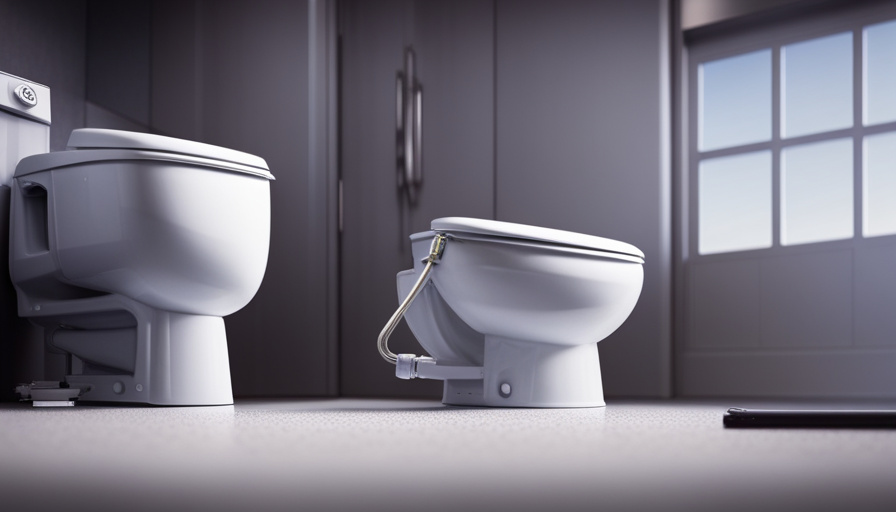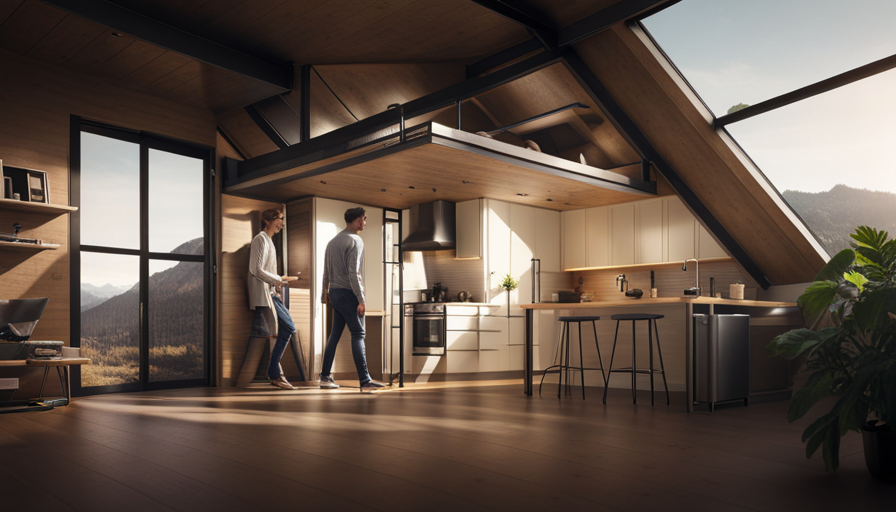Imagine living in a tiny home where every inch is carefully designed for maximum efficiency. In this compact living space, even basic necessities like a toilet require careful consideration.
That’s where a flushable toilet for a tiny house comes in. This ingenious invention not only saves precious space but also provides a convenient and hygienic solution for waste disposal. Designed with a compact and space-saving layout, this toilet utilizes a flushing mechanism that efficiently uses water, ensuring minimal water wastage.
But how does it store the waste? The answer lies in its clever waste storage and disposal system, which ensures odor control and proper ventilation. Additionally, this toilet is eco-friendly, incorporating sustainable features to reduce its environmental impact.
In this article, we will delve into the working mechanism of a flushable toilet for a tiny house, exploring its design, waste storage, odor control, and maintenance. So, let’s take a closer look at how this incredible invention revolutionizes waste management in the tiny house community.
Key Takeaways
- Flushable toilets for tiny houses save space and provide convenient waste disposal.
- They have a compact and space-saving design, making them suitable for installation in any corner or nook.
- The toilets have an efficient flushing mechanism that uses minimal water.
- They have clever systems for odor control and ventilation, ensuring a fresh and odor-free environment.
Compact Design and Space-Saving Features
Get ready to maximize your space with a flushable toilet for your tiny house that saves room without sacrificing functionality! The compact design of this toilet offers several advantages for small living spaces. With its space-saving techniques, you can now have a fully functional toilet without taking up too much room in your tiny house.
The toilet is specifically designed to fit into tight spaces, making it perfect for tiny bathrooms. Its compact size allows for easy installation in any corner or nook, allowing you to make the most of your limited space.
Additionally, the toilet’s innovative design includes features like built-in storage compartments and shelves, further maximizing the usability of your bathroom. With these space-saving techniques, you can create a functional and efficient bathroom in your tiny house.
Now, let’s move on to the flushing mechanism and water usage.
Flushing Mechanism and Water Usage
The flushing mechanism in this compact lavatory efficiently utilizes water while ensuring effective waste removal. When the toilet handle is pressed, a valve opens, allowing water to flow into the bowl. The water creates a swirling motion, carrying the waste down the drain. This flushing action is powered by gravity, requiring minimal water pressure.
The design of the toilet bowl and trapway is optimized to maximize the flushing efficiency, preventing clogs and ensuring thorough waste removal. Despite its small size, this flushing mechanism is capable of handling solid waste effectively. Additionally, the water usage is minimal, reducing the environmental impact.
With this efficient flushing system, waste is quickly and effectively disposed of, ensuring a hygienic and odor-free environment.
Moving on to waste storage and disposal, the next section will discuss how the waste is managed in this flushable toilet for tiny houses.
Waste Storage and Disposal
Once waste is processed by the efficient flushing mechanism, it’s time to address how it’s managed in this compact lavatory.
In a tiny house, waste disposal alternatives are crucial for sustainable waste management. One common option is the use of composting toilets, which separate liquid and solid waste. The solid waste is mixed with organic material such as sawdust or coconut coir, creating an environment for aerobic decomposition. This process helps break down the waste into nutrient-rich compost that can be safely used in gardens or disposed of in an environmentally friendly manner.
As for the liquid waste, it can be diverted to a separate container or a drain field, depending on the system design.
Composting toilets not only minimize water usage but also provide an eco-friendly solution for waste management.
Moving on to the next section about odor control and ventilation, it’s important to consider proper airflow to ensure a pleasant bathroom experience.
Odor Control and Ventilation
When it comes to odor control and ventilation in tiny houses, there are a few key points to consider.
First, ventilation systems are essential in preventing odors from accumulating and becoming unpleasant. These systems help to circulate fresh air and remove any stagnant or foul-smelling air.
Second, there are various methods and products available for odor control in tiny houses, such as air fresheners, deodorizers, and natural remedies like baking soda or charcoal. These can help to neutralize and eliminate odors effectively.
Overall, proper ventilation and odor control are crucial for maintaining a fresh and comfortable living environment in a tiny house.
Ventilation systems to prevent odors
With a ventilation system, the tiny house toilet keeps odors at bay, allowing residents to breathe easy in their cozy abode. Ventilation techniques play a crucial role in odor elimination by constantly exchanging the air inside the toilet with fresh air from outside.
One common method is to install a small fan or exhaust system that draws air out of the toilet and expels it outside. This creates a negative pressure inside the toilet, preventing odors from lingering.
Additionally, some ventilation systems use activated carbon filters to further reduce odors by trapping odor-causing molecules. These filters need to be periodically replaced to maintain their effectiveness.
By implementing proper ventilation techniques, the tiny house toilet ensures a pleasant and odor-free environment.
Moving forward to the next section on odor control methods and products, we will explore additional strategies to enhance the overall experience.
Odor control methods and products
To combat unpleasant smells, homeowners can utilize various odor control methods and products. These methods include air fresheners, scented candles, and natural deodorizers.
Air fresheners release pleasant scents into the air, effectively covering up any unwanted smells. Scented candles burn and release fragrances that can also help mask odors.
Natural deodorizers, on the other hand, use ingredients like baking soda or vinegar to neutralize and eliminate odors instead of just covering them up.
These odor control methods can be used in conjunction with proper waste management techniques to ensure that the tiny house remains fresh and odor-free.
Moving on to the next section about eco-friendly features, it’s important to consider the environmental impact of the odor control products we choose.
Eco-Friendly Features
When it comes to eco-friendly features in tiny houses, two key points to consider are the use of composting or bio-digestion systems and the reduction of water and chemical usage.
Composting or bio-digestion systems provide a sustainable way to manage waste by breaking it down into nutrient-rich compost or biogas. This not only reduces the amount of waste going to landfills but also eliminates the need for traditional sewage systems.
Additionally, by implementing water-saving fixtures and using non-toxic cleaning products, water usage can be significantly reduced while minimizing the negative impact on the environment.
Use of composting or bio-digestion systems
Imagine a magical little ecosystem within your tiny house toilet that effortlessly transforms waste into nutrient-rich compost or bio-digestion material. Composting and bio-digestion systems are eco-friendly alternatives to traditional flush toilets, offering numerous benefits.
Composting allows for the decomposition of organic waste through the help of microorganisms, resulting in nutrient-rich compost that can be used as a natural fertilizer. This process not only reduces waste sent to landfills but also promotes sustainable gardening practices.
On the other hand, bio-digestion uses bacteria to break down waste and produce biogas, which can be used to generate energy. By harnessing the power of nature, these systems minimize environmental impact and provide a sustainable solution for waste management in tiny houses.
Transitioning into the next section, these systems also contribute to the reduction of water and chemical usage, further enhancing their eco-friendly appeal.
Reduction of water and chemical usage
When it comes to the use of composting or bio-digestion systems in a flushable toilet for a tiny house, one of the major benefits is the reduction of water and chemical usage. These systems are designed to minimize the need for excessive flushing and the use of harmful chemicals, making them more eco-friendly. By composting or digesting the waste, these systems effectively break down the organic matter, reducing its volume and eliminating the need for water to carry it away.
This not only helps to conserve water, but also significantly reduces the environmental impact associated with traditional flush toilets. Additionally, these systems are known for their ability to reduce odor, further enhancing their appeal in a small living space.
Transitioning into the subsequent section about maintenance and cleaning tips, it’s important to understand how to properly care for and maintain these systems to ensure their optimal performance.
Maintenance and Cleaning Tips
To keep your flushable toilet in good condition, it’s important to regularly clean and maintain it.
Here are some maintenance tips and cleaning techniques to help you keep your toilet functioning properly. First, make sure to clean the bowl regularly using a toilet brush and a mild cleaner. Scrub the inside of the bowl, including under the rim, to remove any stains or buildup.
Additionally, it’s important to clean the external surfaces of the toilet, such as the seat and handle, to maintain hygiene.
To prevent clogs, avoid flushing excessive amounts of toilet paper or other materials that may not break down easily.
Finally, consider using a septic-safe toilet cleaner to prevent damage to your plumbing system.
With these maintenance and cleaning techniques, you can ensure that your flushable toilet stays in great condition and functions efficiently.
Moving on to considerations and limitations, it’s important to understand the capacity and limitations of a flushable toilet in a tiny house.
Considerations and Limitations
One important consideration to keep in mind is the limited water capacity of your compact restroom, with an average tiny house toilet using only 0.5 gallons of water per flush. This means that you need to be mindful of how much waste you dispose of in order to prevent any overflow or blockages.
Additionally, it’s worth considering alternative waste disposal options such as composting toilets. Composting toilets are a sustainable and eco-friendly option that uses natural processes to break down waste into compost. They require little to no water, making them ideal for tiny house living where water conservation is crucial. These toilets separate solid waste from liquid waste, allowing for easier composting and disposal.
However, it’s important to regularly maintain and properly manage the composting process to ensure odor control and proper decomposition.
Frequently Asked Questions
Can a flushable toilet for a tiny house be used off-grid?
Yes, a flushable toilet for a tiny house can be used off-grid. It’s designed to operate without relying on traditional power sources. Instead, it can be powered by off-grid power systems such as solar panels or batteries.
Additionally, these toilets are designed to minimize water usage, making them more efficient for off-grid living. They typically use a small amount of water to flush waste, and some models even offer options for composting or incineration, further reducing water usage.
How often does the waste storage need to be emptied in a flushable toilet for a tiny house?
To properly maintain a flushable toilet in a tiny house, it’s crucial to regularly empty the waste storage. The frequency depends on your usage, but typically it needs to be emptied every few days or once a week. Failing to do so can lead to unpleasant odors and potential damage to the toilet system.
It’s important to consider the environmental impact of using a flushable toilet in a tiny house and properly dispose of the waste in an eco-friendly manner.
Can a flushable toilet for a tiny house be installed in a bathroom with limited ventilation?
A flushable toilet for a tiny house can be installed in a bathroom with limited ventilation, but it’s important to consider the ventilation limitations. Without proper ventilation, odors and moisture can become a problem. To mitigate this, alternative waste disposal options can be explored, such as composting toilets or incinerating toilets. These options don’t rely on water flushing and can operate without a traditional sewage system. They provide effective waste management solutions while minimizing the need for ventilation.
What types of waste can be safely disposed of in a flushable toilet for a tiny house?
The types of waste that can be safely disposed of in a flushable toilet for a tiny house are human waste and toilet paper. These toilets are designed to handle these types of waste effectively and efficiently. The waste is flushed away using a small amount of water, and it is then transported to a septic system or a designated waste disposal area.
It’s important to note that other types of waste shouldn’t be disposed of in these toilets, as they may cause clogs or damage to the system.
Are there any special cleaning products or techniques required for maintaining a flushable toilet in a tiny house?
When it comes to maintaining a flushable toilet in a tiny house, there are a few things to keep in mind. Firstly, using appropriate cleaning products is essential. Look for biodegradable and eco-friendly options to minimize environmental impact.
Secondly, regular maintenance techniques such as cleaning the bowl and checking for any leaks or clogs are important.
Lastly, be sure to follow the manufacturer’s instructions for any specific cleaning or maintenance requirements to ensure optimal performance of your flushable toilet.
Conclusion
In conclusion, the flushable toilet for tiny houses offers a compact and space-saving solution for waste management. It ensures a hygienic and convenient experience with its efficient flushing mechanism and minimal water usage. The waste storage and disposal system effectively controls odors and provides proper ventilation. Additionally, its eco-friendly features contribute to a sustainable lifestyle.
Regular maintenance and cleaning are crucial to keep the toilet functioning optimally. However, it’s important to consider the limitations and ensure that the toilet meets the specific needs of your tiny house.
Just like a well-oiled machine, this toilet seamlessly integrates into the tiny house, ensuring a smooth and efficient waste management system.
Hi, I’m Emma. I’m the Editor in Chief of Tiny House 43, a blog all about tiny houses. While tree houses are often associated with childhood, they can be the perfect adult retreat. They offer a cozy space to relax and unwind, surrounded by nature. And since they’re typically built on stilts or raised platforms, they offer stunning views that traditional homes simply can’t match. If you’re looking for a unique and romantic getaway, a tree house tiny house might just be the perfect option.










